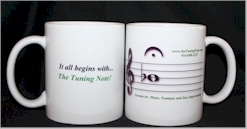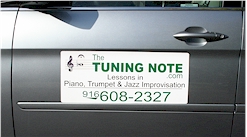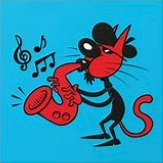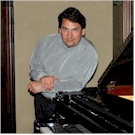
TTN Mugs
Available for purchase.

TTN Hats
Available for purchase.


|
|

The Tuning Note - JAZZ LINGO:
Expressions:
- Axe: Jazz terms for one's instrument. Even said of the voice.
- Blow: The Jazz term for 'improvise.' It has a more mystical aura. Also, simply to play an instrument.
- Chops: Technical ability, to execute music physically and to negotiate chord changes. Distinct from the capacity to have good ideas, to phrase effectively and build a solo.
- Dig: To appreciate a player's expression.
- Head: The first (and last) chorus of a tune, in which the song or melody is stated without improvisation or with minimal improvisation.
- Hip (or Hep): Keenly aware of or knowledgeable about life's developments, especially in the arts. "Hipness is what it is. But sometimes hipness is what it ain't..."
- Improv (Improvisation): The process of spontaneously creating fresh melodies over the continuously repeating cycle of chord changes of a tune. The improviser may depend on the contours of the original tune, or solely on the possibilities of the chords' harmonies, or (like Ornette Coleman) on a basis of pure melody. The 'improv' also refers to the improvisational section of the tune, as opposed to the head.
- Shed: Short for Woodshed, to practice diligently.
Form Related:
- AABA: The most common form in pop music. Typical of songs by Gershwin, Cole Porter, Harold Arlen, etc. See Song Form.
- A Section: The first section of a tune, typically 8 bars; Jazz terms for the main theme.
- Bridge: The contrasting middle section of a tune, especially the 'B' section of an AABA song form. Traditionally, the bridge goes into a different key, often a remote key. Thelonious Monk once remarked that the function of a bridge is 'to make the outside sound good'.
- B Section: Same as bridge.
- Blues: (1) A form normally consisting of 12 bars, staying in one key and moving to IV at bar 5. (2) A melodic style, with typical associated harmonies, using certain 'blues scales', riffs and grace notes. (3) A musical genre, ancestral to Jazz and part of it. (4) A feeling that is said to inform all of Jazz.
- Break (or Solo Break): A transitional passage in which a soloist plays unaccompanied.
- Chorus: One complete cycle of a tune, one time through from top to bottom.
- Interlude: An additional section in a tune, especially one between one person's solo and another's. The Dizzy Gillespie standard A Night In Tunisia has a famous interlude.
- Intro (Introduction): A composed section at the beginning of a tune, heard only once.
- Rhythm Changes: The chords to 'I Got Rhythm' (Gershwin), somewhat modified and simplified. Many Jazz tunes use these changes and every player must know them. There are several variations.
- Shout chorus: A special, complete, through-composed chorus played just before the final out-chorus. Used in classic (20s) Jazz, some bebop, and a few modern compositions, such as Wayne Shorter's This Is For Albert.
- Stop time: A rhythm where certain beats aren't played, e.g. 1 2 3 (rest) 1 2 3 (rest).
- Trading 4s (or 8s, 2s): A form of discontinuous drum solo in which 4 measure sections are alternately played solo by the drummer, and by the band with another soloist (who goes first). The latter can be one particular soloist throughout, or it can cycle through the different instruments. Also, two different instrumental soloists can trade 4s with each other, such as the trumpet and the sax. This is called a chase. Trading 4s usually goes on for one or two choruses.
- Turnaround: A sequence of chords, or the portion of a tune that they occupy, that forms a cadence at the end of a section of a tune, definitively establishes the tonic key and leads back to the opening chord of the next section, or to the top. Typically the turnaround chords are I - VI - ii - V, with half a measure apiece. With possible substitutions and alterations, the variations are infinite. There are also entirely different progressions possible. If the opening chord of the next section is not a I chord, the turnaround must be suitable. Learning to negotiate turnarounds is essential to making a coherent solo. It's often effective to play a phrase that starts partway through a turnaround and continues past the beginning of the next section.
- Vamp: A simple section like a riff, designed to be repeated as often as necessary, especially one at the beginning of a tune. Also a constantly repeated bass line over which a solo is played.
Feels and Tempo:
- Double time: A tempo twice as fast, with the time feel, bar lines and chords moving at twice the speed.
- Double time feel: A time feel twice as fast, so that written eighth notes now sound like quarter notes, while the chords continue at the same speed as before.
- Groove: An infectious feeling of rightness in the rhythm, of being perfectly centered. This is a difficult term to define. A Medium Groove is a tempo of, say, 112, with a slinky or funky feeling.
- Half time: A tempo half as fast.
- Half time feel: A time feel half as fast, while the chords go by in the same amount of time. Occurs in the intro to Chick Corea's Tones for Joan's Bones.
- Latin: (1) Afro-Cuban, Brazilian or other South American-derived. There are many special terms used in Latin music and I haven't tried to include them here. (2) Played with equal eighth notes as opposed to swung (see swing def. 2). Also 'straight-8'. The feel of bossa novas and sambas.
- Up: In a fast tempo.
Performance Related:
- Changes: (1) The chords of a tune. 'Playing' or 'running' the changes means using suitable scales, etc., over each given chord of the tune. Determining the exact changes to use is a big part of preparing a tune for performance. (2) Rhythm Changes (q.v.) for short.
- Chart: (1) Any musical score. (2) A special type of score, used by Jazz musicians. Only the melody line, words (if any) and chord symbols are given. Clef, key signature and meter are given once only, at the beginning. The standards of musical notation and calligraphy are low. Details are often scanty or inaccurate, which encourages the musician to amend and elaborate the chart for his own purposes. Every Jazz musician has his own book of miscellaneous charts. Also see "Lead Sheet".
- Extensions: The ninth, eleventh and thirteenth of a chord.
- Fake Book: A collection of Jazz charts, published without paying royalties and thus illegal (not in the Public Domain.) For decades, a book called '1000 Standard Tunes' circulated; you can still see its grossly simplified charts, written three to a page. Some 25 years ago the "Real Book" appeared, out of the Berklee School of Music, with some 400 tunes in excellent calligraphy. This has become the standard and all Jazz musicians are expected to have a copy. More recently a number of legal fake books have been published. The best is The Ultimate Jazz Fakebook.
- Lay out: Not play. See stroll.
- Lead Sheet: A form of music notation that specifies the melody & harmony (and sometimes the lyric) of a tune. The melody is written in modern Western music notation and the harmony is specified with chord symbols above the staff. A single selection from a Fake Book is also referred to as a lead sheet. Also see "Chart".
- Modal: (1) Said of a section, or a whole tune, having static harmony (using one chord) and using scales from a particular mode, most typically the Dorian. (2) Having a key feeling derived not from dynamic chord progressions (like circle-of-fifths) but rather from repetition, monotony, and weight. (3) Loosely, a harmonic style that is diatonic and makes use of quartal harmony.
- Mode: An incarnation of a scale in which a certain note is taken as the root. Thus, each scale has as many different modes as it has different tones. In common usage, the major scale and the melodic minor scale are regarded as 'given' and the scales constructed with other notes as the root are called modes. The modes of the major scale have names (Ionian, Dorian, Phrygian, Lydian, Mixolydian, Aeolian, and Locrian); these names were applied in the Renaissance and have no relationship to the Greek originals. Some of the melodic minor scale's modes have names in today's theory: mode 3, the augmented major 7th; mode 4, the lydian dominant; mode 6, the half-diminished; mode 7, the altered.
- Quote: A snatch of some other well-known tune thrown into a solo. A good quote is unexpected, incongruous and yet seems to fit perfectly. Some quotes are cliches, as 'Grand Canyon Suite' in 'All the Things You Are'.
- Riff: (1) A relatively simple, catchy repeated phrase. May be played behind a soloist or as part of a head. Often in a bluesy style. Riff tunes are made up of riffs, characteristic of the black bands of the 30s. (2) A pre-packaged phrase used by an improviser when he can't think of anything else, especially one which is especially catchy.
- Rhythm Section: The piano, bass and drums in a combo, those who play throughout the tune, behind the soloists. Might also include guitar or vibes, or there might be no piano.
- Run: A rapid descending, or ascending, usually right-hand passage on the piano in the form of a continuous scale, or a scale with variations.
- Standard: A tune universally accepted and played by many Jazz musicians. Many standards are tin pan alley and Broadway songs from the 30s, 40s and 50s. Others are strictly Jazz compositions. A professional Jazz musician is expected to know many, many standards.
- Syncopation: The process of displacing 'expected' beats by anticipation or delay of one-half a beat. The natural melodic accent which would fall, in 'square' music, on the beat, is thus heard on the off-beat. This adds a flavor of ambiguity as to where the beat is (not an actual ambiguity, only a flavor).
- Tune: A single Jazz composition or Jazz performance, a piece. The word 'song' is frowned on.
- Voicing: A particular arrangement of the notes of a chord in which chosen harmonies color the tone.
- Walk: In bass playing, to play mostly one note per beat, making a smooth, continuous quarter-note line. A fulfillment of the time-keeping function of bass playing, which many bass players have transcended since around 1960. The pianist can also walk with his left hand.
- West Coast School: A much criticized label for the 'Cool' style (q.v.) as it was taken up in California in the early 50s by mostly white players, like Dave Brubeck, Gerry Mulligan, Chet Baker and many lesser figures like pianist Russ Freeman. In addition to the typical features of cool Jazz, the style experimented with 'classical' instruments and complex counterpoint.
More:
Scale Related:
- Altered scale: The dominant 7th scale with a lowered 9th, raised 9th, raised 11th, no fifth, and lowered 13th, along with the usual root, 3rd and 7th. So-called because every possible alteration has been made.
- Diminished Scale: A scale of 8 notes to the octave in alternating whole-steps and half-steps. There are just three different diminished scales. Quite a complicated system of voicings and motivic patterns for diminished has been developed by modern players.
- Pentatonic: Pertaining to scales of 5 notes to the octave, in particular 1-2-3-5-6 of the major scale. Pentatonic melodies are typical of much indigenous music around the world, and these scales are also an important part of the modern Jazz sound. Pentatonic melodies and patterns were especially typical of Jazz and fusion in the seventies.
- Whole-tone: A 6-note scale, of which there are two, made up entirely of whole-step intervals, or the harmonies derived from it. Used by Debussy and suggestive of 'impressionism'. In Jazz, associated with Thelonious Monk and explored in a number of hard bop originals.
|












